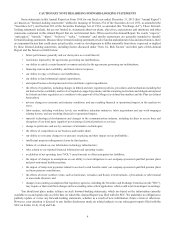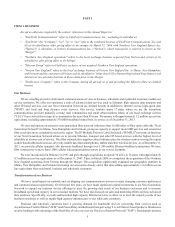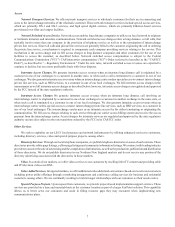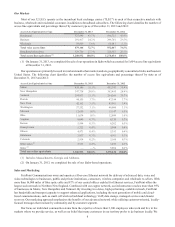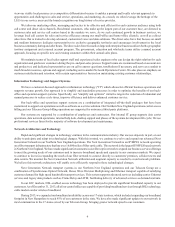FairPoint Communications 2013 Annual Report Download - page 16
Download and view the complete annual report
Please find page 16 of the 2013 FairPoint Communications annual report below. You can navigate through the pages in the report by either clicking on the pages listed below, or by using the keyword search tool below to find specific information within the annual report.14
FCC New Rules for ICC System. The CAF/ICC Order reformed rules associated with local, state toll and interstate toll
traffic exchanged among communications carriers including ILECs, CLECs, cable companies, wireless carriers and VoIP providers.
The new rules, the majority of which were effective beginning July 1, 2012, established separate rules for price cap carriers and
rate-of-return carriers. Although the FCC order treats our rate-of-return carriers (including companies operating under average
schedules) as price cap carriers for CAF funding, it treats them as rate-of-return carriers for purposes of ICC reform. For both
price cap and rate-of-return carriers, the FCC established a multi-year transition of terminating traffic compensation to "bill and
keep", or zero compensation. For both price cap and rate-of-return carriers, the FCC required carriers to establish fiscal year 2011
("FY2011") baseline compensation, which was the amount of relevant compensation billed during the period beginning October 1,
2010 and ending September 30, 2011, and collected by March 31, 2012. This FY2011 revenue was used as a starting point for
revenue for the transitional period, which is six years for price cap operations and nine years for rate-of-return operations. For
each FairPoint ILEC, the FY2011 baseline revenue is reduced by a specified percent during each year of the transition, resulting
in a target revenue for each tariff year. At the same time, the FCC rules require reductions in ICC rates for specified services and
jurisdictions. As the recoverable revenue declines and the rates decline, any target revenue which will not be covered by ICC
revenue can be recovered, in part, from end users through an access recovery charge ("ARC"). Price cap ILECs are permitted to
implement monthly end user ARCs with five annual increases of no more than $0.50 for residential/single-line business consumers,
for a total monthly ARC of no more than $2.50 in the fifth year; and no more than $1.00 (per month) per line for multi-line business
customers, for a total of $5.00 (per month) per line in the fifth year, provided that: (1) any such residential increases would not
result in regulated residential end user rates that exceed the $30.00 residential rate ceiling; and (2) any multi-line business customer's
total subscriber line charge ("SLC") plus ARC does not exceed $12.20. Rate-of-return ILECs are permitted to implement monthly
end user ARCs with six annual increases of no more than $0.50 (per month) for residential/single-line business consumers, for a
total ARC of no more than $3.00 in the sixth year; and no more than $1.00 (per month) per line for multi-line business customers
for a total of $6.00 (per month) per line in the sixth year, provided that: (1) such increases would not result in regulated residential
end user rates that exceed the $30.00 Residential Rate Ceiling; and (2) any multi-line business customer's total SLC plus ARC
does not exceed $12.20. We began billing the ARC charges for our price cap and rate of return companies in July 2012 as outlined
by the rules above. If the combination of ICC and ARC revenue is not sufficient to cover the targeted revenue, then additional
funding will be provided by the CAF in certain circumstances, though there is no guarantee that the ILEC will be made whole.
Vermont Incentive Regulation Plan
Effective April 1, 2011, we entered into an Incentive Regulation Plan ("IRP") for our Northern New England Vermont service
territory. The IRP includes a 2011-2015 Amended Retail Service Quality Plan ("RSQP"), which significantly reduced FairPoint's
exposure to retail service quality index ("SQI") penalties from $10.5 million to $1.65 million. As of March 31, 2013, the RSQP
and related SQI penalties were eliminated in Vermont based upon our achievement of certain retail service metrics. We believe
the IRP has allowed our Northern New England operations' retail rates in Vermont to compete with those competitive carriers
under a relatively level regulatory scheme, while preserving certain regulatory protections for consumers in areas where competition
may not be adequate. The IRP expires on December 31, 2014 and, in order to maintain favorable regulatory treatment, which
includes pricing flexibility, reduced regulatory oversight, elimination of automatic service quality penalties and more flexible rate
filing options, we will need to extend the IRP or propose a successor IRP to the Vermont Public Service Board ("VPSB").
Legislation for Maine and New Hampshire
During the middle of fiscal year 2012, legislation was enacted into law in both Maine and New Hampshire, which decreased
the scope of retail telecommunications regulation for us, eliminating many of the state-specific Merger conditions and providing
us with increased ability to compete in the Maine and New Hampshire telecommunications marketplace.
Effective August 10, 2012, the New Hampshire legislature enacted Chapter 177 (known as Senate Bill 48) ("SB 48") in its
Session Laws of 2012. SB 48 created a new class of telecommunications carriers known as "excepted local exchange
carriers" ("ELECs") and our Northern New England operations qualify as an ELEC in New Hampshire. SB 48 essentially leveled
the regulatory scheme imposed upon New Hampshire telecommunications carriers and states that the New Hampshire Public
Utilities Commission ("NHPUC") has no authority to impose or enforce any obligation on a specific ELEC that also is not applicable
to all other ELECs in New Hampshire except with respect to:
(i) Obligations that arise pursuant to the Communications Act, as amended;
(ii) Obligations imposed on our Northern New England operations that arose prior to February 1, 2011 that relate to the
availability of broadband services, soft disconnect processes and capital expenditure commitments within New
Hampshire;
(iii) Obligations that relate to the provision of services to CLECs, interexchange carriers and wireless carriers, regardless
of technology; or
(iv) Certain obligations related to telephone poles and carrier of last resort responsibilities.


